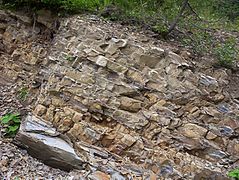Flysch
The flysch are rocky facies of sedimentary origin composed of rhythmic alternation of layers of hard cohesive rocks (limestone, slate or sandstone) interspersed with other softer, friable ones (marls or shales). This disposition favors differential erosion, since the friable layers are worn more easily than the cohesive layers. This causes the hard layers to remain in prominence and without support, which is thus more easily eroded, but at the same time the existence of the hard rocks protects the soft ones.
The term comes from German and is relatively old, created before the detailed study of the phenomenon it describes. It means 'flow', 'slide' or 'sliding ground'.
Training
This type of alternating sedimentation has been the subject of numerous controversial investigations. There have been two working hypotheses about its formation: until the 1950s the hypothesis of fossil beaches was defended, but later the hypothesis of turbidity currents in the deep areas of the ocean prevailed..
- Fossil beaches. This hypothesis defends the formation of the flysch has been carried out from coastal sedimentation, in a phenomenon similar to the formation of the beaches. It was based on the appearance of the surface of the sandy layers in which there are cracks, signs that remind the figures left by the waves in the sands of the beaches. From this observation it was passed to the conjecture that they should be literate beach sediments.
- With peats. The most accepted hypothesis is that of sediment formation in deep ocean areas. These sediments would be from the ocean currents of great turbidity that run through the slope of the fund leaving sediments called turbidites. The observed rites are now interpreted as current, not waves.
Based on the turbidite hypothesis, it can be estimated that the flysch is formed as follows:
- a current with sediment loading slides through a talud on the abyss bottom of the ocean excavating a structure on the original surface of the ocean or that has left an earlier episode of this same type;
- by slowing down the sedimentation of the material that drags the current into different layers ordered by the densities of the same. These sediments are laminate;
- when the current calms down, the lightest materials form the clay parts of the whole.
Examples of flysch outcrops
In the north of the Iberian Peninsula, between the Gipuzkoan towns of Deva and Zumaya, is the so-called Ruta del Flysch, it is one of the most relevant flysch and where its best value is appreciated. structure, in addition to all sections of the Paleocene, with an excellent conservation of the fossil record. It forms the Geopark of the Basque Coast, included in the UNESCO network of world geoparks. Further west are more examples such as the Costa Quebrada de Cantabria in the municipality of Piélagos with the Arnía beach.
In the south of the Iberian Peninsula there are also formations of this type, in the unit called Flysch del Campo de Gibraltar, with outcrops in the stretch of coast between the towns of Algeciras and Tarifa.
Contenido relacionado
Castries
Vermellar
Nepal





